A Concrete Example NCERT Solutions | English Poorvi Class 8 - New NCERT PDF Download
| Table of contents |

|
| Let us do these activities before we read. |

|
| Let us discuss |

|
| Let us think and reflect |

|
| Let us learn |

|
| Let us speak |

|
| Let us write |

|
| Let us explore |

|
Let us do these activities before we read.
I) Read the names of items you usually find in a garden and write their names against each picture given below.
garden hoşe, sapling, hedge, flower beds, flower pot, pebbles, rockery, fence, vine, wheelbarrow
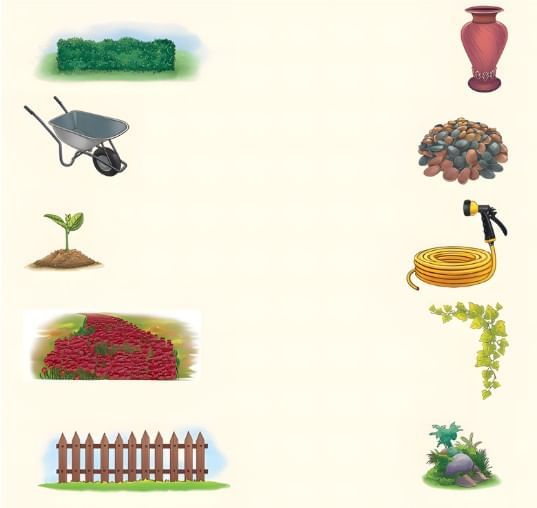
Ans: 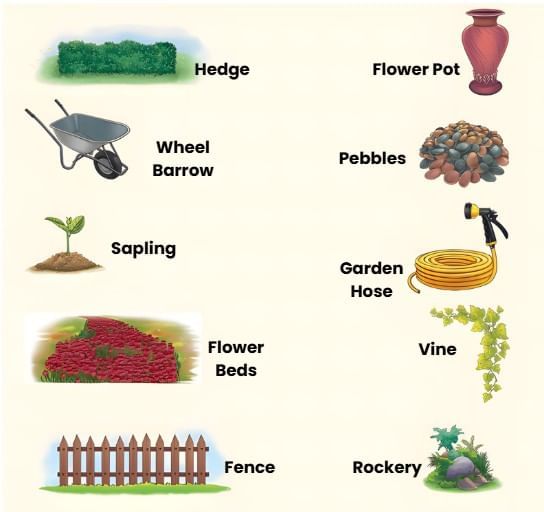
II) Work in groups of four. What kind of garden would you like to have? Mention the features that you can include and the reasons for your choice. Share your answers with your classmates and teacher.
Ans:
Type of Garden: We would like to have a Butterfly Garden.
Features to Include:
- Colorful flowers like marigolds, sunflowers, and zinnias to attract butterflies.
- A small water pond for butterflies to drink.
- A bench to sit and watch the butterflies.
- A signboard with butterfly names and pictures.
Reasons for Choice:
- Butterflies are pretty and fun to watch, making the garden lively.
- It helps save butterflies, which are important for nature.
- We can learn about different butterfly species while enjoying the garden.
- It’s easy to make with flowers and a little water, so we can do it at school.
Group Discussion Tip: In your group, talk about what you all like—flowers, vegetables, or rocks like Mrs. Jones’s garden. Decide together and add your own ideas, like a treehouse or a rock path. Share your plan with the class and see what others think!
III) Read the title of the poem. What comes to your mind when you read the word 'concrete'? Does it have more than one meaning? Share your answers with your classmates and teacher.
Ans: When I read the word "concrete," the first thing I think of is the hard, gray material used in construction—like buildings, roads, and bridges. Yes, "concrete" can have two different meanings:
- Literal Meaning: A strong, man-made building material made of cement, sand, and gravel.
Example: "The sidewalk is made of concrete." - Figurative Meaning: Something real, specific, or definite (not abstract).
Example: "She gave concrete evidence to prove her point."
Let us discuss
I. Complete the following summary with exact words from the poem. One example has been done for you. Share your answers with your classmates and teacher.
The poem describes Mrs. Jones, the speaker's next-door neighbour, who has a unique garden filled with 1__________. Her garden includes a peculiar 2___________, a pond, and a rockery, along with an unusual 3____________. that she finds charming. Mrs. Jones plants tiny, 4___________. plants between the stones, which the speaker thinks must be so small that they are planted with a 5________________. One day, Mrs. Jones invites the speaker to see her garden, and they discuss a 6_____________. that Mrs. Jones treasures. When the speaker asks where the 7_____________. flower is, Mrs. Jones says that the speaker has been 8._______________ on it all along.
Ans: The poem describes Mrs. Jones, the speaker's next-door neighbour, who has a unique garden filled with stones. Her garden includes a peculiar crazy path, a pond, and a rockery, along with an unusual sundial that she finds charming. Mrs. Jones plants tiny delicate plants between the stones, which the speaker thinks must be so small that they are planted with a pin. One day, Mrs. Jones invites the speaker to see her garden, and they discuss a flower that Mrs. Jones treasures. When the speaker asks where the lovely flower is, Mrs. Jones says that the speaker has been standing on it all along.
The answers are exact words or phrases from the poem:
1. stones
2. crazy path
3. sundial
4. delicate
5. pin
6. flower
7. lovely
8. standing
II. Select the correct option to fill in the blanks for the following sentences.
- The tone of the poem is
(i) mocking
(ii) humorous
(iii) mournful
(iv) amusing
(v) light-hearted
A. (i), (ii), and (iii)
B. (i), (ii), and (v)
C. (ii), (iii), and (iv)
D. (ii), (iv), and (v)
Answer:D. (ii), (iv), and (v)
The poem’s tone is humorous (ii), amusing (iv), and light-hearted (v), as it playfully describes Mrs. Jones’s peculiar garden and the speaker’s funny mistake of stepping on the flower. It is not mocking (i) or mournful (iii), as the tone is gentle and fun. The speaker in the poem is
(i) Mrs. Jones
(ii) the poet
(iii) a gardener
(iv) a child
Answer: (ii) the poet
The speaker is the poet, Reginald Arkell, who uses the first-person “I” to narrate their visit to Mrs. Jones’s garden and their humorous interaction.The rhyme scheme of the poem is
(i) AABBCC
(ii) ABAВСС
(iii) AABСАС
(iv) ABBАСС
Answer: (i) AABBCC
The poem’s rhyme scheme is AABBCC, with each stanza having six lines where the first two rhyme (e.g., “Jones/stones”), the next two rhyme (e.g., “pond/beyond”), and the last two rhyme (e.g., “device/nice”). The options are identical, so any choice (e.g., i) is correct.
III. Complete the following sentences by choosing the correct answer given in the brackets.
The poet uses the word 'stones' in all stanzas in order to emphasise her ______________ (obsession with a stony garden/ pride in gardening skills.)
Ans: The poet uses the word 'stones' in all stanzas in order to emphasise her obsession with a stony garden.
Explanation: The word “stones” appears in each stanza, highlighting Mrs. Jones’s focus on her stone-filled garden, reflecting her obsession with its unique, stony features rather than just pride in gardening.The poet uses imagery to describe the features of the garden that help readers________________. (understand Mrs. Jones'love for plants/visualise the garden's peculiar nature)
Ans: The poet uses imagery to describe the features of the garden that the readers understand the garden's peculiar nature.
Explanation: Imagery like “crazy path,” “lily pond,” and “sundial with a strange device” vividly shows the garden’s unusual and peculiar nature, not just Mrs. Jones’s love for plants.
IV. Pick examples of alliteration from the poem.
Answer: Alliteration means when the same sound is repeated at the beginning of nearby words. For example:
- “My next-door neighbour” – the ‘n’ sound is repeated.
- “Strange device” – the ‘s’ sound is repeated.
These are the examples of alliteration in the poem.
V. A refrain is a repeated line or phrase that appears in each stanza. Identify the refrain from the poem.
Answer: “My next-door neighbour, Mrs. Jones”. This line is repeated at the start of each stanza (lines 1, 7, 13), serving as a refrain that emphasizes Mrs. Jones’s central role and her unique garden.
VI. Irony is a literary device that emphasises the difference between what is expected and what actually happens. It often involves a situation where the outcome is the opposite of what is expected, creating a surprising or a humorous effect. For example, Mrs. Jones’ excitement about her garden contrasts with the speaker’s disappointment on how ordinary it is.
Identify the line(s) from the poem that display(s) situational irony.
Answer: Situational irony occurs when the outcome is the opposite of what is expected. The speaker expects the “lovely” flower to be prominent and visible, but Mrs. Jones reveals they are standing on it, creating a surprising and humorous contrast between expectation and reality. Lines from the poem that display situational irony are:
- “Where is this lovely thing?” I cried.
- “You’re standing on it,” she replied.
VII. Complete the following sentences appropriately.
The word 'concrete' can refer to _____________________in Mrs. Jones’ garden.
Ans: The word 'concrete' can refer to the stones or stone-based features like the crazy path, rockery, and sundial in Mrs. Jones’ garden.The title also has a symbolic meaning, as the poem provides a clear or 'concrete' example of Mrs. Jones' ______________gardening habits.
Ans: The title also has a symbolic meaning, as the poem provides a clear or 'concrete' example of Mrs. Jones’ peculiar gardening habits.
VIII. The title 'A Concrete Example' carries both literal and symbolic (metaphorical) meaning. Such word play is called a pun. A pun is a figure of speech that uses words with multiple meanings or words that sound alike but have different meanings, creating a humorous effect.
- I tried arguing with my pencil but it kept making sharp points. (suggests the idea of an actual sharp pencil point and strong argument points)
- My pencil and I had a disagreement but we finally got to the point. (refers to solving an argument and the pencil's tip)
Let us think and reflect
I. Read the given extract and answer the questions that follow.
Extract:
My next-door neighbour, Mrs. Jones,
has got a garden full of stones:
A crazy path, a lily pond,
a rockery and, just beyond
A sundial with a strange device,
which Mrs. Jones thinks rather nice.
What can be inferred about Mrs. Jones’s taste in gardening from the description of her garden being ‘full of stones’?
Answer: Mrs. Jones has an unusual and unique taste in gardening, preferring stones and peculiar features over typical plants and flowers. The garden’s stone-dominated features, like the “crazy path,” “rockery,” and “sundial,” suggest she enjoys unconventional and artistic garden designs, distinct from traditional gardens with plants.Identify whether the following statement is true or false: The garden serves as a means to reveal more about Mrs. Jones herself.
Answer: True
The garden’s unique stone features and tiny plants reflect Mrs. Jones’s peculiar personality and unconventional taste, revealing her character through her gardening style.What does the poet mean by ‘crazy path’?
Answer: The poet means a winding, unusual path made of stones that is not straight or typical. The term “crazy path” uses vivid imagery to describe a twisting, unconventional stone path, emphasizing the garden’s peculiar and artistic design.What does the sundial with a ‘strange device’ suggest about Mrs. Jones’ personality?
A. She has a fascination with unusual items.
B. She prefers traditional garden decorations.
C. She is uninterested in her garden’s appearance.
D. She likes modern and expensive items.
Answer: A. She has a fascination with unusual items.
The “sundial with a strange device,” which Mrs. Jones finds “rather nice,” suggests she enjoys peculiar and unusual items, aligning with her unique garden style, not traditional, indifferent, or modern preferences.
II. Answer the following questions.
How does Mrs. Jones feel about her garden? Support your answer with evidence from the poem.
Answer: Mrs. Jones feels proud and fond of her garden. The poem states she thinks the sundial’s “strange device” is “rather nice” and invites the speaker to see her stones, showing her enthusiasm. Her positive description of the sundial and her invitation to the speaker highlight her pride and affection for her unique stone garden.Why do you think the speaker describes the plants as being so small that they could be planted with a ‘pin’?
Answer: The speaker describes the plants as so small to exaggerate their tiny size, humorously suggesting they are insignificant and hard to plant. The line “unless she plants them with a pin” uses hyperbole to emphasize the delicate, tiny nature of the plants, contrasting with the large stones and adding humor.What do we get to know about Mrs. Jones based on her gardening style and her interaction with the speaker?
Answer: Mrs. Jones is peculiar, enthusiastic, and values her unique garden. Her interaction, where she calmly says, “You’re standing on it,” shows her gentle humor and patience. Her stone-filled garden with tiny plants and her pride in showing it to the speaker reveal her unconventional taste, while her calm response reflects a kind, humorous personality.The poem portrays Mrs. Jones in a positive light. Support this statement.
Answer: The poem portrays Mrs. Jones positively by showing her enthusiasm for her unique garden and her gentle humor when the speaker steps on her flower. Her pride in the “rather nice” sundial and her patient, humorous reply, “You’re standing on it,” present her as likable and good-natured, not upset by the mistake.What does the poem tell us about the way people think differently about the world around them?
Answer: The poem shows that people have different perspectives, as Mrs. Jones values her tiny plants and stone garden, while the speaker sees the plants as insignificant. The contrast between Mrs. Jones’s pride in her “delicate” plants and the speaker’s view that they “don’t mean anything at all” highlights how people perceive the same things differently.
Let us learn
I. Select the appropriate word from the brackets that correctly replaces the underlined word in the sentences from the text.
A sundial with a strange device. (unusual, peculiar, new, rare, external)
Answer: peculiar
“Peculiar” means unusual or distinctive, fitting the context of the sundial’s unique design, which Mrs. Jones finds appealing.… which Mrs. Jones thinks rather nice. (pleasant, superior, agreeable, gentle, charming)
Answer: pleasant
“Pleasant” conveys a positive, agreeable feeling, similar to “nice,” describing Mrs. Jones’s approval of the sundial.They are so delicate. (delicious, fragile, dainty, graceful, weak)
Answer: dainty
“Dainty” means delicately small and pretty, aligning with the poem’s description of the tiny, fragile plants placed between stones.‘Where is this lovely thing?’ I cried. (exclaimed, wept, shouted, announced, whispered)
Answer: exclaimed
“Exclaimed” means to speak suddenly with emotion, fitting the speaker’s excited question about the flower’s location.
II. The ‘sundial’ is referred to as a ‘device’ in the poem. Work in pairs to infer the meaning of ‘device’. Share your thoughts with your classmates and teacher.
Answer: In the poem, a “device” refers to a tool or object designed for a specific purpose, here the sundial, which uses the sun’s shadow to tell time.
Now, match the type of instruments in Column 1 with their definitions in Column 2. Column 3 shows one example of each type of instrument. Add more examples in Column 3.
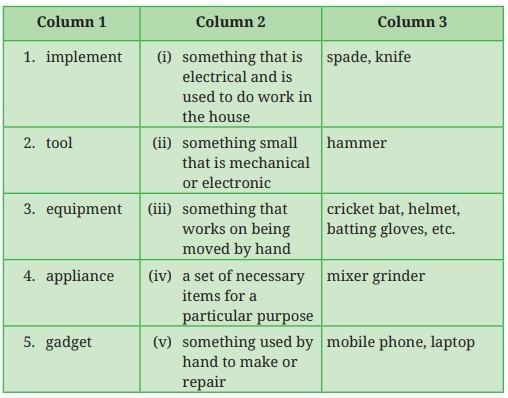 Answer:
Answer:
| Column 1 | Column 2 | Column 3 |
|---|---|---|
| 1. implement | (iii) something that works on being moved by hand | Spade, knife, hoe, scissors, screwdriver |
| 2. tool | (v) something used by hand to make or repair | hammer, screwdriver, wrench |
| 3. equipment | (iv) a set of necessary items for a particular purpose | Cricket bat, helmet, gloves, lab equipment, gym machines |
| 4. appliance | (i) something that is electrical and is used to do work in the house | Mixer grinder, refrigerator, washing machine, microwave, toaster |
| 5. gadget | (ii) something small that is mechanical or electronic | Mobile phone, laptop, smartwatch, calculator, drone |
III. Complete the table by making new words in Column 1 using the hints given new in Column 2. Replace the first letter of the given word to create words. One example has been done for you.
1.
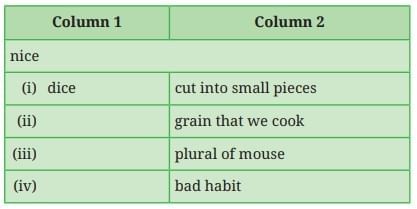 Ans:
Ans:
| Column 1 (Type of Word) | Column 2 (Hint) | Column 3 (Examples or Related Terms) |
|---|---|---|
| 1. Nice | Pleasant feeling | Kindness, smile, warmth |
| 2. Dice | (i) Dice cut into small pieces | Cubes, bits, chopped vegetables |
| 3. Rice | (ii) Grain that we cook | Porridge, sushi, pilaf |
| 4. Mice | (iii) Plural of mouse | Rodents, pests, small animals |
| 5. Vice | (iv) Bad habit | Smoking, laziness, gambling |
2. 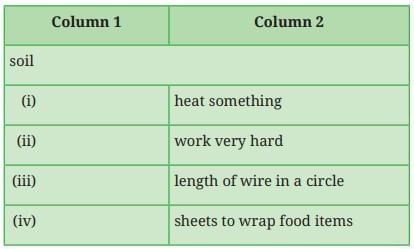
Ans:
| Column 1 (Type of Word) | Column 2 (Hint) | Column 3 (Examples or Related Terms) |
|---|---|---|
| 1. Soil | Earth or ground material | Dirt, mud, clay |
| 2. Boil | (i) Heat something | Water, soup, vegetables |
| 3. Toil | (ii) Work very hard | Labor, effort, farming |
| 4. Coil | (iii) Length of wire in a circle | Spring, rope loop, cable |
| 5. Foil | (iv) Sheets to wrap food items | Aluminum wrap, plastic cover |
Let us speak
I. The speaker of the poem might have felt sorry for stepping on Mrs. Jones' flower. When we make a mistake, we must express regret and apologise for our actions.
1. When we apologise to a friend or a family member, we use informal language. Take turns to apologise for the following situations and respond to the apology.
(i) You have eaten your brother's share of sweets.
(ii) You have broken your sister's flower craft.
(iii) You accidentally spilled ink on your mother's important documents.
(iv) You forgot to bring your friend's notebook to the school after borrowing it.
You may use the following phrases given below.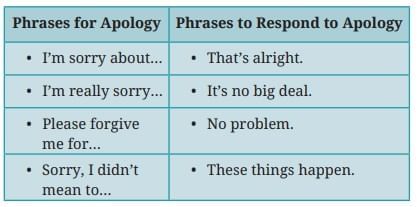
Ans: The speaker of the poem might have felt sorry for stepping on Mrs. Jones's flower, and we should express regret when we make mistakes. Below are apologies and responses for the given situations using informal language.
(i) You have eaten your brother's share of sweets.
- Apology: "I'm really sorry about eating your sweets, bro. I didn’t mean to!"
- Response: "That’s alright, but save some for me next time!"
(ii) You have broken your sister's flower craft.
- Apology: "Sorry, I didn’t mean to break your flower craft, sis. Please forgive me!"
- Response: "No problem, but be careful next time. These things happen."
(iii) You accidentally spilled ink on your mother's important documents.
- Apology: "I’m sorry about spilling ink on your documents, Mom. It was an accident!"
- Response: "It’s no big deal, but please be more careful in the future."
(iv) You forgot to bring your friend's notebook to school after borrowing it.
- Apology: "I’m really sorry for forgetting your notebook, buddy. Please forgive me!"
- Response: "That’s alright, just bring it tomorrow. No problem!"
2. When we apologise to someone in authority like a Principal or a teacher in a formal setting, we use formal language. Work in pairs and take turns to apologise for the following situations and respond to the apology.
(i) You did not bring an assignment that was due for submission.
(ii) You the Principal. were late to school for the past three days and had to meet
(iii) You did not submit your project work and were asked to explain. You may use the phrases given below.
You may use the phrases given below.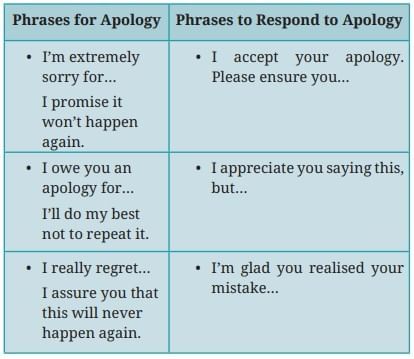
Ans: When apologizing to a Principal or teacher, we use formal language. Below are apologies and responses for the given situations, worked in pairs, using formal phrases.
(i) You did not bring an assignment that was due for submission.
- Apology: "I’m extremely sorry for not bringing my assignment, Sir/Ma’am. I promise it won’t happen again."
- Response: "I accept your apology. Please ensure you submit it tomorrow."
(ii) You were late to school for the past three days and had to meet the Principal.
- Apology: "I owe you an apology for being late to school for the past three days, Principal. I’ll do my best not to repeat it."
- Response: "I appreciate you saying this, but please be on time from now on."
(iii) You did not submit your project work and were asked to explain.
- Apology: "I really regret not submitting my project work, Sir/Ma’am. I assure you that this will never happen again."
- Response: "I’m glad you realised your mistake. Please submit it by the end of this week."
Let us write
You are a member of the Nature Club of your school. Draft a notice informing the students of Grades 6-8 about the inauguration of the Herb Garden. 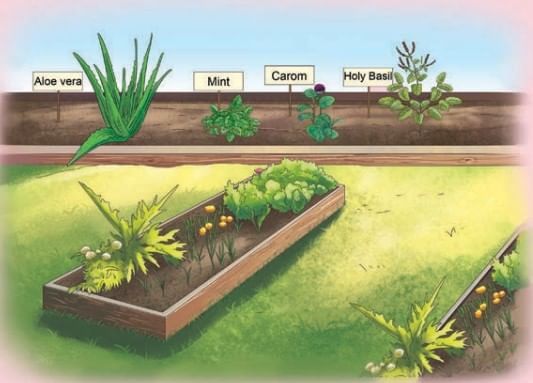
Points to remember:
- Mention the purpose of writing, date, time, venue, and any other relevant information-whom to contact, when, and where.
- Use formal language in the third person form.
- Write the notice in a box.
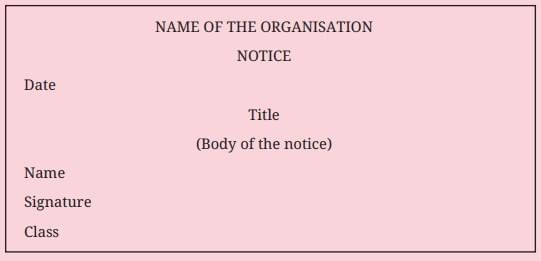
Ans:
DELHI PUBLIC SCHOOL, Delhi
NOTICE
Nature Club
Inauguration of the Herb Garden!
The Nature Club is pleased to announce the inauguration of the new Herb Garden, aimed at promoting awareness about medicinal plants and sustainable gardening among students. All students of Grades 6-8 are invited to attend the event. The details are as follows:
- Date: 25th July 2025
- Time: 10:00 AM – 11:30 AM
- Venue: School Courtyard (Near Science Block)
Students are encouraged to participate and learn about the benefits of herbs. For further information, please contact the Club Coordinator, Ms. Sharma, at the school office between 2:00 PM and 3:00 PM on weekdays.
Let’s grow green together!
Name: Aryan Patel
Signature:
Class: 8B
Let us explore
I. Amrit Udyan is a garden spread over an expanse of 15 acres around Rashtrapati Bhavan in New Delhi. It has multiple attractions that include a specially curated garden for children called Bal Vatika, a treehouse, nature's classroom, etc. It also has the Bonsai, Herbal-I, Herbal-II, Tactile Garden, Arogya Vanam, and Circular Gardens with a diverse variety of flora and fauna.
Now, find out about popular gardens in your region and share with your classmates and teacher.
Ans: Example (If your region is Mumbai):
- Garden Name: Sanjay Gandhi National Park (Borivali)
- Location: Borivali East, Mumbai
- Area: ~104 sq. km
- Attractions: Lion & Tiger Safari, Kanheri Caves, Nature Trails, Butterfly Park
- Unique Features: One of the largest national parks within a city, rich biodiversity.
II. A herbarium is a collection of plant samples preserved for long-term study, usually in the form of dried and pressed plants mounted on paper. Now, collect some fallen flowers and leaves from your neighbourhood. Place them in folds of a newspaper carefully and put a pile of books on them. After one week, take them out and use them to make a card, wall hanging or any other artwork. A sample has been given for your reference.
III Read and enjoy the poem.
A Sea of Foliage
A sea of foliage girds our garden round,
But not a sea of dull unvaried green,
Sharp contrasts of all colours here are seen;
The light-green graceful tamarinds abound
Amid the mango clumps of green profound,
And palms arise, like pillars gray, between;
And o'er the quiet pools the seemuls lean,
Red-red, and startling like a trumpet's sound.
But nothing can be lovelier than the ranges
Of bamboos to the eastward, when the moon
Looks through their gaps, and the white lotus changes
Into a cup of silver. One might swoon
Drunken with beauty then, or gaze and gaze
On a primeval Eden, in amaze.
- TORU DUTT
|
58 videos|435 docs|57 tests
|
FAQs on A Concrete Example NCERT Solutions - English Poorvi Class 8 - New NCERT
| 1. What are the key concepts covered in the NCERT Solutions for Class 8? |  |
| 2. How can NCERT Solutions benefit students in their studies? |  |
| 3. Are NCERT Solutions aligned with the current curriculum? |  |
| 4. How can students effectively use NCERT Solutions for exam preparation? |  |
| 5. Where can students find NCERT Solutions for Class 8? |  |





















